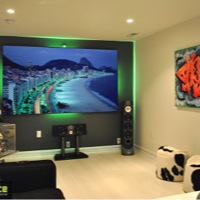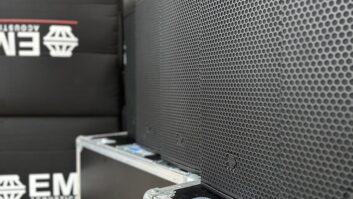
It was a cliché of 1960s Hollywood, the millionaire bachelor pad, where at the touch of a button the villain – they were always villains, these millionaire bachelors – could convert an ordinary luxury apartment into a seduction paradise. Drapes would close, lights would dim, the sofa would morph into a king-size divan, soft music would play… and leggy lovelies would succumb. Actually it was boys who succumbed. Leggy lovelies tended to be gadget-proof, but lads – they were seduced, all right. All they lacked (give or take a million dollars) was the technology to make the dream come true. Fast forward half a century and not only do we have the technology, but the interim stages of an integrated residential AV set-up –multi-room speaker systems, for example – are relatively commonplace, even for ordinary folk. And with millionaires (as distinct from villains) now almost a cliché, there’s a whole heap of residential audio solutions available to anyone prepared to invest a few dollars more. So what are the boys asking for these days? And how aware of current technology are they? “Based on our business experience,” says Todd Anthony Puma, president of The Source Home Theater Installation & Design Corporation, “the customer doesn’t know any technical detail to speak of.” Puma’s company, based in New York, typically deals with well-off clients wanting an audio-video solution to suit their swanky homes. These people aren’t suckers (you don’t get rich by being an easy mark), and the testimonials on The Source’s website show they shop around before buying… but the sale itself is generally an educational process. “We ask what they’re looking for and suggest the speakers, controllers, TVs etc,” Puma says. “Ours is a referral business – our clients find out about systems we’ve installed when visiting friends’ houses or at parties.” The testimonials prove that too. One of The Source’s recent installations is the ‘Man Cave’ for Amani Toomer, a former New York Giants American footballer (see case study, page 30) – and the company’s site is littered with testimonials about their own systems from Toomer’s team mates. Puma notes two distinct markets for residential audio. “The bachelor client is trying to show off – to his friends, to girls, to his significant other and so on. He wants this stuff to be seen, so we use floor-standing systems, all the toys.” That changes when the bachelor succumbs. “Family clients want something easy to use for everybody. They want settable remotes, not touchscreens that young children can scratch and wreck. They always want the speakers hidden – and everything out of the reach of the kids.” Although there are completely invisible speaker solutions, Puma’s personal preference is architectural speakers such as Paradigm. “We often specify ceiling speakers – and being a design company we do appreciate and can answer the need for architecturally harmonious solutions.” An alternative approach is to make the speakers a feature in themselves – which is the route chosen by Waterfall Audio, a French company specialising in glass speakers.“The market split, in our experience, is not a simple matter of bachelor versus family,” says Waterfall’s export manager, Nadine Chaix-Dewell, “although we might recommend families with young children to go for ‘on wall’ speakers rather than traditional floorstanding units. However, because our speakers give excellent sonic performance, the typical buyer will be the luxury lifestyle enthusiast, who loves beautiful objects that he can be proud of and show to his friends. But in Waterfall’s case, the ‘Women Acceptance Factor’ is at its best, as women have finally found an object they can be proud of showing. So the man can have his wonderful music with no aggravation with his partner!” Dewell also finds customers are rarely aware of the options available. “The education process starts right at the dealer or integrator’s door, and even upstream from them with the interior designer or architect, the ones who have the direct contact with the customer. And even when a customer knows exactly what he wants, it is sometimes not relevant to what he needs. “We, as manufacturers and through our distributors, must make sure these channels are educated. Their education is done through professional press, shows, training etc… but then we have to rely on these channels to pass on the message. We get some direct contact with the end users through press and shows, but it’s limited considering the number of potential customers.” Heard but not seenIt’s exactly the same problem faced by Amina Technologies, which makes ‘plaster-over’ speakers – not traditional cone-shaped drivers, but based on the concept of reproducing sound from a vibrating surface, like a musical instrument’s soundboard. Designed for use in historic buildings (where speakers would look out of place) or in modern, minimalist spaces to avoid compromising the architectural intention, the flatpanel speakers are installed into walls or ceilings before the final skim of plaster. “Our challenge is that, despite our best efforts, most people are not even aware that invisible loudspeakers are an option,” explains Babs Moore, Amina’s sales director. “We try to promote through three routes. First, direct to the general public, through shows such as Home Building and Renovation, and with advertising and editorial in magazines, to help create a pull from the market. “Next, to create a push in the market, we encourage and support our installers by taking part in their local shows, providing demo equipment, running training events with them and so on. “And we see architects and designers as key influences, so we do the 100% Design exhibition in London each year (part of London Design week and very successful for us) and we’re also supplier members of the RIBA (architects) and BIID (interior designers) associations, and run approved CPD training sessions for both. “Once the customer becomes aware that invisible speakers are a viable option we are a long way towards making a sale.” So far, so designerly – but what do hi-fi buffs think, and won’t such a radical solution have cost implications? “It is worth noting that the incoherent waveform produced by vibrational sound means our speakers are more tolerant of an acoustically harsh environment common to modern minimalist designs than conventional cone-in-a-box solutions,” Moore says. “Realistically our products are only going to be used in new builds or where major renovation is taking place, and this fact alone will influence decision makers. Budget is an issue, but speaker price is largely irrelevant compared to project cost. Our speakers retail from around £1,000-£2,000 per pair – making them comparable with good quality speakers from the likes of Bose and B&W, but they’re not at the top-end price points of KEF, Meridian and others. “I never dodge the price issue when talking to customers,” she says. “If someone wants a £199 home theatre speaker system from Tesco they are not our customers. Similarly if someone wants to spend £10k–£50k on his speakers to show off to his mates the last thing he wants to do is to hide them!” Moore also recognises the divide between ‘bachelor’ and ‘family’ audio systems. “Women are great fans of our speakers as most hate the look of ceiling speakers as much as I do. We are used in whole-house audio systems and in home theatres (combined with a sub, often Velodyne in-wall, which is the most discreet one we know).” But there’s more to it than that, she says. “There are other, more subtle, distinctions. Plaster-over speakers are pretty germ proof (and have been used in operating theatres), they’re thief proof, toddler proof and they’re beer proof. People taking our products are going to be homeowners, and typically it will be the kind of house (rarely with a less-than-seven-figure price tag) where aesthetics are key. “You do get a far larger sweet spot using dispersive speakers like ours than conventional point sources but sometime real audiophiles want to hear the discrete point sources.” Style versus substanceRegardless of the relative merits of different speaker systems, what about the source material? Is the compressed MP3 format good enough? How do integrators reconcile client requests for top-end speakers with their use of streaming services such as Spotify? “We don’t try to persuade clients not to use Spotify and MP3 systems – you’ve got to live in the present day,” says Puma. “It’s a new century, and CDs are going away. Instead we use processing to give MP3s a richer, more rounded sound. You get out of your car where you’ve been listening to your iPod MP3s and come indoors and hear your music on the systems we install and you feel like you’re in a different world.” And anyway, there are some more upmarket solutions, points out David Rodarte, president & CEO of NuVo Technologies, a company with self-proclaimed ‘music in its veins’ which specialises in zoned audio solutions for home audio. “Even as digital audio has become the norm, music-lovers are more aware than ever of quality in relation to the content itself,” he says. “Mastered for iTunes by Apple, as an example, is digital content that offers users an option for better listening, for less compression, for more pristine reproduction. The objective for high-end manufacturers is to develop equipment with easy access to the multitude of digital content sources while protecting the fidelity of the audio, so that what you hear is the content at its absolute best – always.” And manufacturers are bringing hi-fi streaming products to market, points out James Drummie, product manager at UK distributor AWE. “The British audio manufacturer Arcam has embraced the new digital music formats,” he says. “Using 30 years of audiophile engineering experience Arcam’s computer and streaming music products deliver outstanding audio quality with products like its iPod/iPad dock and its digital to analogue converters.” But the sad truth is that residential audio isn’t synonymous with top-end hi-fi. Perhaps the last word should go to Babs Moore, with a realistic (and salutory) appraisal of what the market really wants. “The popularity of the compressed MP3 format does tell us that an awful lot of people just like having music and are not that obsessed with the real quality of what they listen to. Our market is those wanting good room-filling sound and stunning aesthetics.” n www.amina.co.ukwww.awe-europe.comwww.nuvotechnologies.comwww.thesourcehometheater.comwww.waterfallaudio.com







